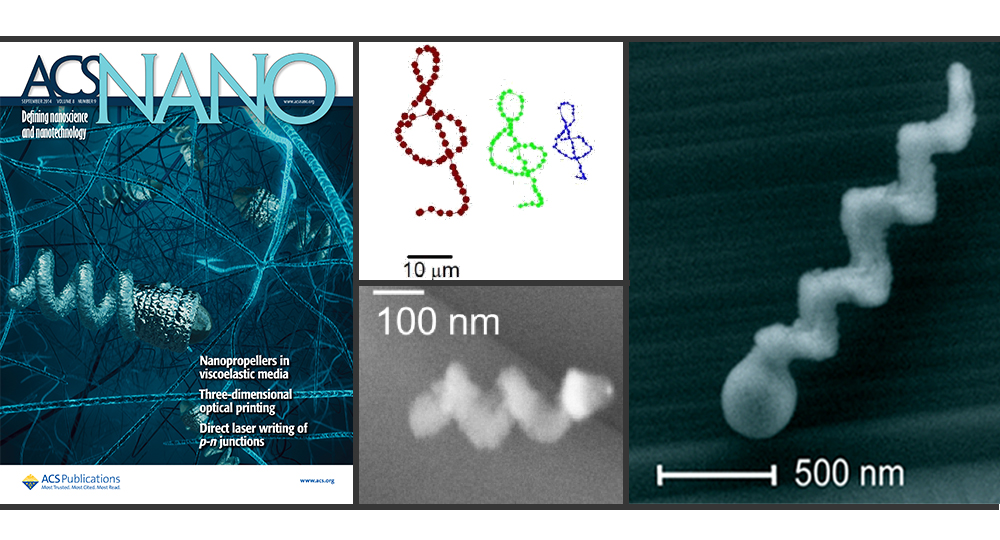
Micropropeller and their propulsion trajectories controlled by the magnetic field. Nanopropellers can move through porous biological tissues.
Nanopropellers and their Biomedical Application
Tian Qiu, Dandan Li, Moon Kwang Jeong, Jonas Troll, Peer Fischer
Former members: Debora Walker, Andrew Mark, Zhiguang Wu, Hyeon-Ho Jeong
We have developed fabrication tools (see nanoGLAD) that allow us to make the world’s smallest drills and propellers. We can drive them through fluids and even tissues.
We have realized the smallest and best controlled magnetically actuated propellers and they can be moved through water with excellent control. These are magnetized and they can be controlled with small rotating external magnetic fields. We achieve movement with fine control and 3D as is seen in the figure.
Since it is still challenging for all existing microrobots to “drill” through real biological viscoelastic fluids, gels and soft tissues, we are working on overcoming this challenge with nanopropellers. Motion through biological tissues is essential for many envisioned medical applications, such as targeted drug delivery and minimally-invasive surgery.
We are working on novel physical and chemical strategies. In order to penetrate the dense mesh-like network of macromolecules that are typically found in biological gels, we use our unique nano-3D-fabrication capabilities (nanoGLAD) to grow nanopropellers that are so small that they are smaller than the mesh size of these molecular networks. There they can move unhindered.
We have also used enzymes to enable propulsion through gastric mucus, which is an approach that mimics the strategy used by the bacterium Helicobacter Pylori. The enzyme-coated propellers change the local rheology of the mucus by changing the pH, and thus our artificial propellers to drill through gastric mucus.
Biological media include a wide range of fluids, ranging from viscous liquids, to viscoelastic fluids, and viscoelastic solid tissues. Thus, we are studying the rheology of typical biological media and developing effective propulsion schemes to penetrate various biological samples. Our findings and inventions advance particle based delivery methods.
Zhiguang Wu, Jonas Troll, Hyeon-Ho Jeong, Qiang Wei, Marius Stang, Focke Ziemssen, Sven Schnichels, Tian Qiu, Peer Fischer. A swarm of slippery micropropellers penetrates the vitreous body of the eye. submitted (2018).
Walker, D., Käsdorf, B. T., Jeong, H.-H., Lieleg, O., Fischer, P. Enzymatically active biomimetic micropropellers for the penetration of mucin gels. Science Advance. 1, e1500501 (2015).
Schamel, D. et al. Nanopropellers and their actuation in complex viscoelastic media. ACS Nano 8, 8794-8801, (2014).
Tian Qiu, Debora Schamel, Andrew G. Mark, and Peer Fischer. Active Microrheology of the Vitreous of the Eye applied to Nanorobot Propulsion. IEEE International Conference on Robotics and Automation (ICRA), Talk, May 31 - June 7, 2014, Hong Kong, China (Best automation paper award - Finalist)
Ghosh, A., Fischer, P. Controlled propulsion of artificial magnetic nanostructured propellers. Nano Lett. 9, 2243-2245, (2009).







